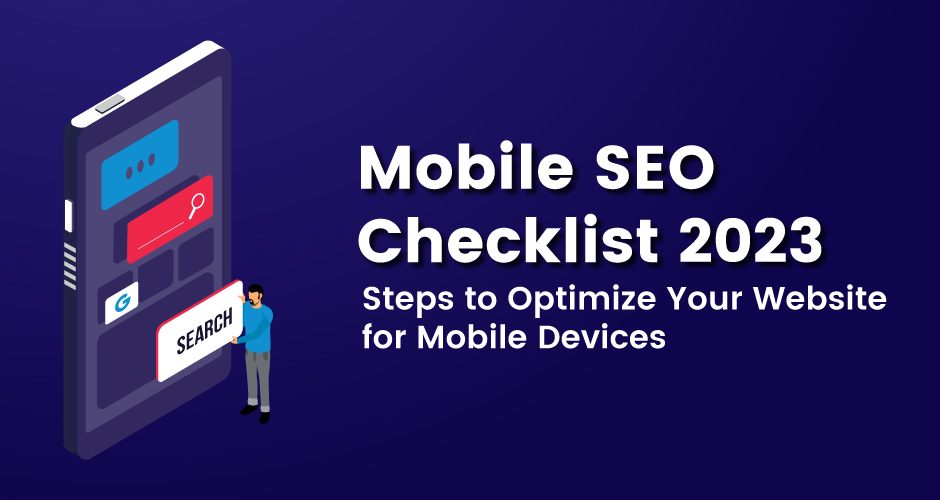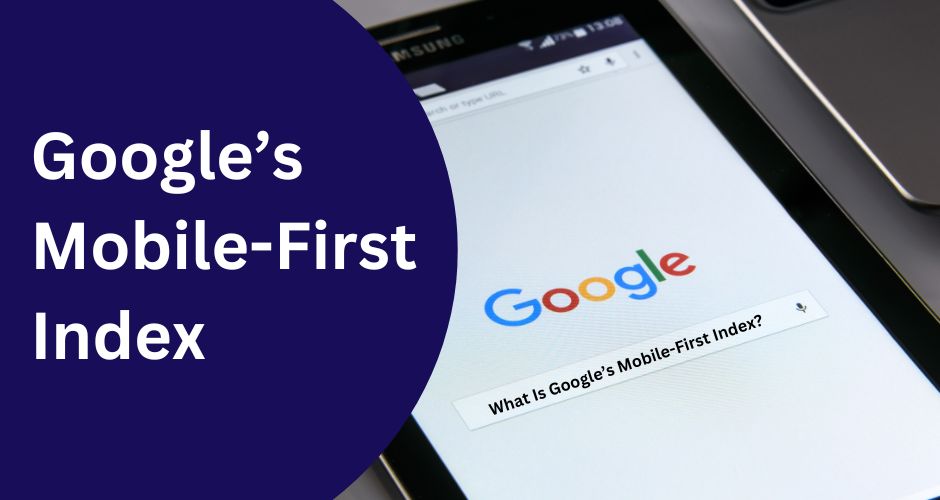
Mobile SEO involves optimizing a website to make it user-friendly and easy to navigate on mobile devices. Is your website optimized for mobile? Our mobile SEO checklist can help you enhance your site’s mobile performance and attract more traffic. In today’s digital landscape, it is crucial for businesses to prioritize the optimization of their websites for mobile devices. Between 2023 and 2028, the global number of mobile internet users is projected to experience steady growth, reaching a total increase of 908.4 million users (+17.4 percent). In this blog, you will delve into the realm of mobile SEO and gain deep knowledge on a comprehensive checklist to guarantee that your website is fully optimized for mobile users.
What is Mobile SEO?
Mobile SEO refers to the practice of optimizing a website to ensure its functionality, usability, and visibility on mobile devices like smartphones and tablets. With the increasing number of people accessing the internet through mobile devices, mobile SEO has become crucial for businesses to stay competitive in the digital landscape.
Mobile SEO involves several techniques and strategies to improve the mobile user experience and make the website easily accessible on smaller screens. This includes implementing responsive design, which allows the website to adapt and adjust to different screen sizes and resolutions. It also involves optimizing page load times to ensure fast and smooth performance on mobile devices.
Furthermore, mobile SEO emphasizes creating mobile-friendly content that is easy to read and navigate on smaller screens. This involves using concise paragraphs, clear headings, and properly formatted images to enhance readability and user experience.
Search engines like Google have recognized the importance of mobile optimization and now prioritize mobile-friendly websites in their search results. Websites that are not optimized for mobile devices may experience lower search rankings and reduced organic traffic.
Why Is Mobile SEO Important for Online Businesses?
Mobile SEO plays a vital role in ensuring that websites are accessible, user-friendly, and optimized for growing mobile users. Did you know that over 58.33% of website traffic worldwide originates from mobile devices? This statistic highlights the growing importance of optimizing your website for mobile devices. If you fail to develop your website as mobile responsive, this means that you could be losing out on a substantial amount of traffic and potential customers. Mobile SEO is highly beneficial for online businesses due to several reasons:
1. Increased Mobile Usage
With the widespread use of smartphones and tablets, more people are accessing the internet through mobile devices. By implementing mobile SEO strategies, businesses can reach a larger audience and tap into the growing mobile user base.
2. Enhanced User Experience
Mobile SEO focuses on optimizing websites for mobile devices, ensuring that users have a seamless and enjoyable browsing experience. Mobile-friendly websites with fast loading times, responsive design, and easy navigation attract and retain users, increasing engagement and higher conversion rates.
3. Higher Search Engine Rankings
Search engines prioritize mobile-friendly websites in their mobile search results. By implementing mobile SEO techniques such as responsive design, mobile-friendly content, and optimized page speed, businesses can improve their search engine rankings and visibility, driving more organic traffic to their websites.
4. Competitive Advantage
As mobile usage continues to rise, businesses that neglect mobile SEO risk falling behind their competitors. By investing in mobile SEO, businesses can remain one step ahead of their competitors and gain a competitive edge in the online marketplace.
5. Local Search Optimization
Mobile devices are often used for local searches, such as finding nearby businesses or services. By implementing mobile SEO strategies, businesses can optimize their online presence for local searches, increasing their visibility to potential customers in their target geographical area.
6. Improved Brand Reputation
A mobile-friendly website reflects positively on a business and enhances its brand reputation. When users have a positive experience on a mobile-optimized website, they are more likely to perceive the business as professional, trustworthy, and credible.
Embracing mobile SEO is crucial for businesses looking to thrive in today’s mobile-driven digital landscape.
Is “SEO” Now About Optimizing For “Mobile SEO”?
In today’s mobile-driven world, optimizing your website for mobile devices has become a fundamental aspect of SEO. While traditional SEO strategies remain relevant, prioritizing mobile optimization is now equally crucial.
In line with this shift, Google has emphasized the significance of mobile-friendliness as a ranking factor for search results.
What Is Google’s Mobile-First Index?

Google’s Mobile-First Index is a major update to its search algorithm that prioritizes mobile versions of websites for indexing and ranking in search results. In the past, Google primarily relied on desktop versions of websites to determine their relevance and ranking. However, with the significant rise in mobile usage, Google recognized the need to adapt its indexing process to reflect the mobile-first nature of online browsing.
Google’s Mobile-First Index works by crawling and indexing the mobile version of a website first, considering it as the primary source for evaluating the content, relevance, and user experience. This means that if a website has a desktop and mobile version, Google will primarily use the mobile version to determine its ranking signals. If a website doesn’t have a mobile version, the desktop version will still be indexed, but it may not perform as well in mobile search results.
The shift to the Mobile-First Index is a response to the growing number of users accessing the internet through mobile devices, including smartphones and tablets. Google aims to provide users with the best possible experience by prioritizing mobile-friendly websites in search results. With the Mobile-First Index, Google is effectively encouraging website owners to optimize their sites for mobile devices to ensure they remain competitive in search rankings.
To adapt to Google’s Mobile-First Index, website owners and webmasters should consider the following mobile SEO tips:
1. Responsiveness
Ensure your website is mobile-responsive, adjusting and displaying properly on various screen sizes and resolutions.
2. Mobile-Friendly Design
Optimize the design and layout of your website to enhance mobile user experience, including easy navigation, readable fonts, and touch-friendly elements.
3. Page Speed
Improve loading speed for mobile devices by optimizing images, reducing server response time, and minimizing code and script files.
4. Content Consistency
Ensure that the content on your mobile version matches the content on the desktop version. Consistency in content helps Google understand your website’s relevance and provides a seamless user experience.
5. Structured Data
Implement structured data markup on your mobile website to provide additional context and information to search engines, improving the visibility and presentation of your content in search results.
By prioritizing mobile optimization and aligning with Google’s Mobile-First Index, businesses can enhance their online visibility, improve user experience, and ultimately drive more organic traffic to their websites. It is essential to stay updated with Google’s guidelines and best practices for mobile optimization to maintain a competitive edge in the evolving digital landscape.
Related Blog- https://www.w3era.com/mobile-seo-everything-you-need-to-know-about-it/
What Does Google Mean by “Mobile”?
According to Google, mobile devices encompass those equipped with a small screen and touch-based interface. This classification extends to smartphones, tablets, and even selected laptops. Consequently, optimizing your website for all variations of mobile devices becomes crucial to secure favorable search rankings and deliver a seamless user experience to mobile visitors.
Moreover, Google has developed a helpful tool called the Mobile-Friendly Test. This resource enables website owners to evaluate their mobile-friendliness and identify areas that require improvement. By leveraging this tool, you can gain valuable insights into how well your website caters to mobile users and make necessary adjustments to enhance its performance on mobile devices.
Is Google’s Mobile-First Index A Big Deal?
The Mobile-First Index introduced by Google is a significant development in the world of online search. With over half of all internet traffic originating from mobile devices, it is clear that mobile optimization is crucial. Google has acknowledged this user behavior shift and adjusted its indexing approach accordingly.
Instead of relying on desktop versions of websites, Google now prioritizes mobile versions for indexing and ranking in search results. This means that the mobile version of a website carries greater weight when it comes to determining its visibility and position in search rankings.
Consequently, websites not optimized for mobile devices may face consequences such as a decline in search rankings and a decrease in organic traffic. As mobile usage continues to rise, it is vital for businesses to adapt and ensure their websites are mobile-friendly to stay competitive in the online landscape.
By embracing mobile optimization, businesses can improve their chances of reaching and engaging with a larger audience. Mobile-friendly websites enhance user experience and align with Google’s mobile-first approach, increasing the likelihood of higher search rankings and organic traffic.
To thrive in this mobile-driven era, website owners should prioritize mobile optimization, ensuring that their sites are responsive, visually appealing, and easy to navigate on mobile devices. Regularly monitoring and optimizing for mobile SEO best practices can help businesses capitalize on the opportunities presented by Google’s Mobile-First Index and maximize their online presence.
How To Conduct Mobile SEO Audit Using Checklist
Mobile optimization is an essential aspect to consider for the success of your website. If you aim to enhance your mobile search rankings and provide a superior user experience for mobile users, conducting a mobile SEO audit is imperative. To guide you through the process, here are the steps you should follow:
1. Understand Your Mobile Traffic
Start by analyzing your website’s traffic data to gain insights into the percentage of visitors accessing your site from mobile devices. Use analytics tools to identify mobile user behavior, including the pages they visit, bounce rate, and conversion rate.
2. Check If Your Site Is Mobile Friendly
Use Google’s Mobile-Friendly Test tool to evaluate your website’s mobile compatibility. Ensure your website design and layout are responsive, adjusting seamlessly to different screen sizes and resolutions. Verify that the text is easily readable without zooming and that buttons and links are appropriately spaced for touch interaction.
3. Check If Your Website Is Mobile-Friendly Using the New Google Search Console
Access the Mobile Usability report in Google Search Console to identify any mobile-specific issues or errors on your site. Address any warnings or errors related to mobile usabilities, such as viewport configuration, content sizing, or touch element placement.
4. Speed Up Your Mobile Website
Page loading speed is crucial for mobile users. Use tools like Google’s PageSpeed Insights to analyze your site’s performance. Optimize images, minify CSS and JavaScript files, leverage browser caching, and consider using AMP (Accelerated Mobile Pages) for faster loading times.
5. Make Your Site Responsive
Implement a responsive web design approach to automatically ensure your site adjusts to different screen sizes. Use fluid grids, flexible images, and CSS media queries to create a seamless browsing experience across devices.
6. Check Your Pop-Ups are Mobile Friendly
Review any pop-ups on your site to ensure they do not interfere with the mobile user experience. Avoid using intrusive pop-ups that cover the main content or are difficult to close on mobile devices.
7. Optimize Your Content for Mobile Users
Create concise and scannable content that is easy to read on smaller screens. Use shorter paragraphs, headings, bullet points, and relevant visuals to enhance readability. Ensure your content is optimized for mobile search intent and includes relevant keywords.
8. Implement Mobile UX Best Practices
Focus on delivering a user-friendly experience on mobile devices. Optimize navigation menus for easy access, ensure clickable elements are easily tappable, and provide a clear and intuitive user interface.
9. Conduct a Mobile Keyword Strategy
Research and identify mobile-specific keywords and phrases that align with your target audience’s mobile search behavior. Optimize your website’s content and meta tags to include these mobile keywords and improve your visibility in mobile search results.
10. Optimize Titles and Descriptions to Improve Mobile SEO
Optimizing your website’s titles and descriptions is a crucial step to improve your mobile SEO. Titles and descriptions are the first things that customers see in search results. They play a key role in attracting clicks to your website. There are some tips to optimize your website’s descriptions and titles for mobile devices:
- Keep it short and concise
Users have limited screen space on mobile devices, so keeping your titles and descriptions brief is essential. Aim for a maximum of 60 characters for titles and 155 characters for descriptions to ensure they are fully displayed.
- Incorporate target keywords
Including your target keywords in titles and descriptions is vital for search engine optimization. This helps your website rank for relevant search queries and improves click-through rates from organic search results.
- Use action-oriented language
Engage users and encourage them to click through to your website by using action-oriented language. Words like “discover,” “learn,” “explore,” or “find out” can create a sense of curiosity and excitement.
- Utilize numbers and symbols
Make your titles and descriptions visually appealing by using numbers and symbols. These can help your content stand out in search results and attract more clicks. Consider using symbols like arrows or stars to draw attention to your titles and descriptions.
- Incorporate local keywords
If your business has a local presence, including local keywords in your titles and descriptions is essential. This helps improve your visibility in local search results and attract relevant local traffic.
By following this checklist, you can ensure that your website is optimized for mobile devices, providing a seamless user experience and improving your search rankings in mobile search results.
Conclusion
Mobile SEO plays a vital role in the digital era, with the growing trend of using mobile devices for web browsing. A mobile SEO checklist is indispensable to optimize your website for mobile devices and achieve better rankings in mobile search results. Implementing the checklist’s steps can enhance your website’s mobile performance, attract more traffic, and ultimately boost your business’s success. It is crucial to conduct regular mobile SEO audits to ensure ongoing optimization for the latest mobile devices and search engine algorithms. You can stay active in adapting to the mobile landscape to maintain a competitive edge and drive positive results for your website.
W3Era is a leading provider of top-notch mobile SEO services. With our expertise and experience, we offer the best solutions to optimize your website for mobile devices. Our services encompass a comprehensive approach that ensures your website performs exceptionally well in mobile search results, attracting higher traffic and achieving your business goals. You can trust W3Era as the best mobile SEO agency for providing unmatched mobile SEO services that deliver outstanding results.
In addition to providing mobile SEO services, we also offer small business SEO services to reach businesses to new heights. Our tailored solutions are designed to help small businesses reach new heights by improving their online visibility, driving organic traffic, and maximizing their digital presence. You can avail of our local SEO packages at affordable prices in order to be visible on top of search engine results pages.
- SEO Powered Content & PR Distribution. Get Amplified Today.
- EVM Finance. Unified Interface for Decentralized Finance. Access Here.
- Quantum Media Group. IR/PR Amplified. Access Here.
- PlatoAiStream. Web3 Data Intelligence. Knowledge Amplified. Access Here.
- Source: https://www.w3era.com/mobile-seo-checklist/




